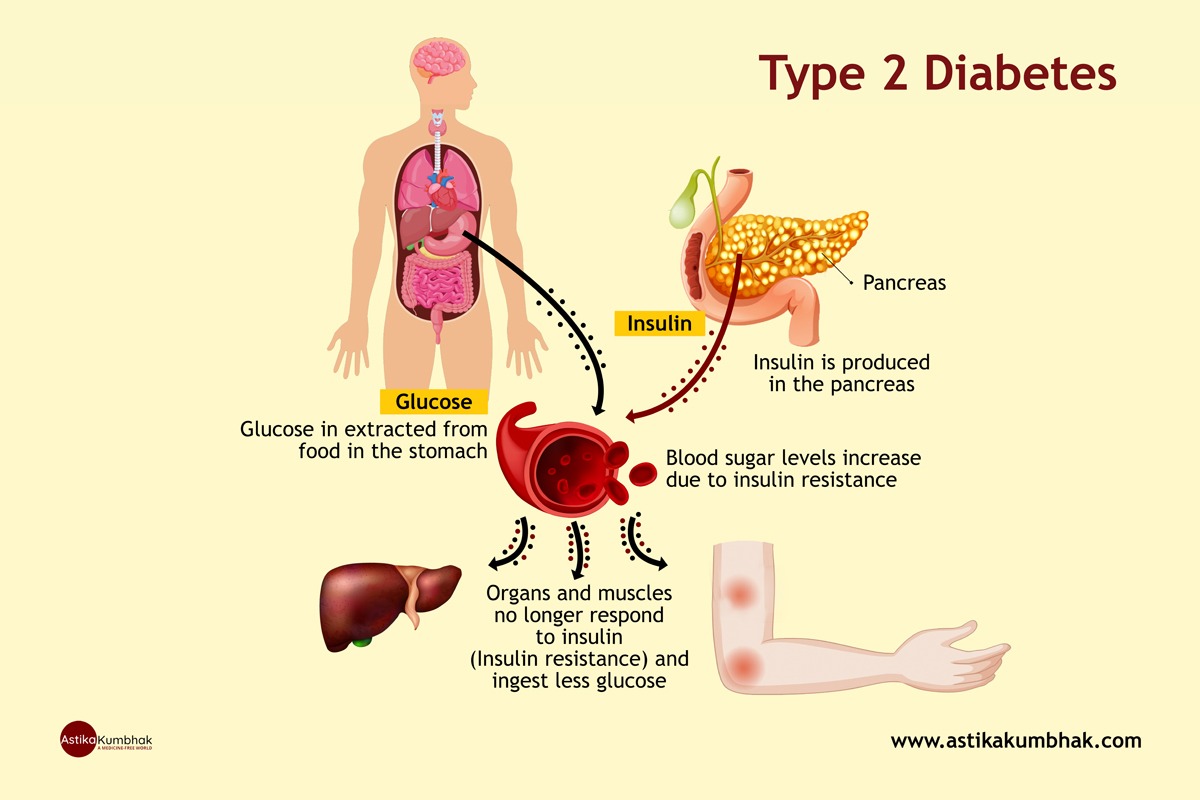Type 2 Diabetes is a chronic metabolic disorder resulting from your body’s inefficient use of insulin.
Type 2 diabetes is a common form of Diabetes mellitus that happens when your pancreas is unable to produce enough insulin, the hormone that regulates the sugar levels in your bloodstream. This eventually leads to too much sugar circulating in your blood. When this happens, it leads to detrimental disorders in your circulatory, nervous, and immune systems.
Type 2 is typically characterised by high blood sugar, insufficient insulin, and insulin resistance. It is more likely to affect people who are middle-aged or older. That said, Type 2 diabetes can affect anyone, including children, due to factors like obesity and lack of exercise.
This condition can be effectively managed to lead a normal life or even reversed with the right approach. This blog aims to give better insights into Type 2 Diabetes.

Who is more likely to develop Type 2 Diabetes?
We know you need an answer to the question “What are the chances of me being diagnosed with Type 2 Diabetes?”
Let us shed more light into this.
Type 2 diabetes can strike anytime and is influenced by a combination of genetic predisposition, detrimental lifestyle choices, and lack of physical activity. You are more likely to develop Type 2 Diabetes if you are aged 45 and over, obese, or have a family history of diabetes. You are also more susceptible to Type 2 Diabetes if you have prediabetes or had gestational diabetes while pregnant.
For some inexplicable reason, there is a high chance of you developing Type 2 diabetes depending on your race and ethnicity too.
Hard Facts about Type 2 Diabetes
Though many individuals are aware of the fact that he/she is susceptible to developing diabetes quite suddenly, there are some facts that come as eye-openers. They show us that the danger is lurking quite nearer, and it is time to rethink our lifestyle choices and make needed changes before it is too late. The worrying part is that diabetes is often asymptomatic
The 9th edition of the IDF Diabetes Atlas predicts that by the year 2045, 1 in 8 adults will be living with Type 2 Diabetes. This is a whopping 46% increase from the present.
Surprisingly enough, the prevalence of Type 2 Diabetes varies significantly by region. The Western Pacific region has the highest number of people with diabetes, closely followed by South East Asia.
As per the Indian council of Medical Research’s India Diabetes Study published in 2023, 101 million individuals over the age of 18 are affected by Type 2 Diabetes.
The alarming fact is that over 25 million are pre diabetics and at the risk of developing Type 2 diabetes in the near future. Sadly, many individuals are unaware of their diabetic status and miss seeking medical attention on time.
In January 2024, a reputed publication reported the rising incidence of Type 2 Diabetes amongst individuals in their early 20s and 30s in the past 2 decades. This just means that we are all in the cusp of a global diabetes epidemic.
As per studies, women are found to be more susceptible to an early onset of Type 2 Diabetes.
In India, many individuals lack proper awareness about Type 2 Diabetes.
There is a misconception among youth that Type 2 Diabetes only affects the elderly. This makes them miss out the initial signs of Type 2 diabetes, thereby leading to a delayed diagnosis and health complications.
According to leading diabetic health experts, it is better to go for an early screening if
- A 20 year old male has a waist circumference over 80 centimetres.
- A 20 year old female has a waist circumference over 90 centimetres.
There is one or more family members diagnosed with Type 2 Diabetes. This is because if both parents are diabetic, the risk of you getting diagnosed with Type 2 Diabetes is 90% and if one parent is diabetic, the risk is 70%.
Maintaining a healthy body weight and avoiding chronic stress can eliminate upto 90% of diabetes cases.
For some inexplicable reason, the progress from prediabetes to diabetes is quite rapid in the Asian population compared to other ethnic groups.
Several studies have shown that proactive approach can prevent diabetes from developing in ⅔ of the individuals with prediabetes.
Type 2 Diabetes is quite common, but awareness about it is not. It is time to correct this fallacy to facilitate quicker diagnosis, on-time medical care, and proactive management.
